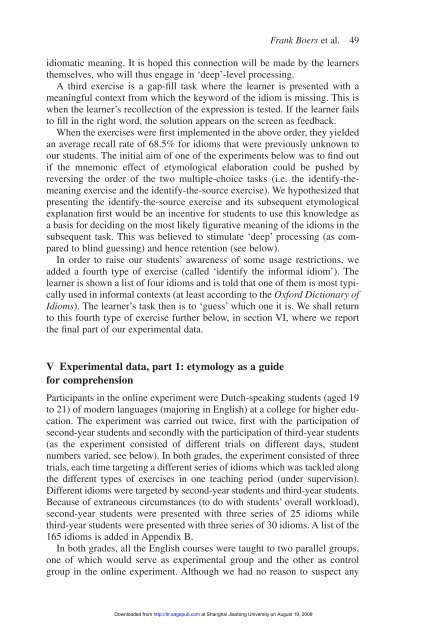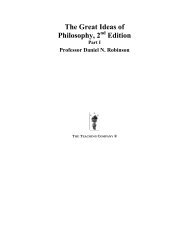Language Teaching Research
Language Teaching Research
Language Teaching Research
You also want an ePaper? Increase the reach of your titles
YUMPU automatically turns print PDFs into web optimized ePapers that Google loves.
idiomatic meaning. It is hoped this connection will be made by the learners<br />
themselves, who will thus engage in ‘deep’-level processing.<br />
A third exercise is a gap-fill task where the learner is presented with a<br />
meaningful context from which the keyword of the idiom is missing. This is<br />
when the learner’s recollection of the expression is tested. If the learner fails<br />
to fill in the right word, the solution appears on the screen as feedback.<br />
When the exercises were first implemented in the above order, they yielded<br />
an average recall rate of 68.5% for idioms that were previously unknown to<br />
our students. The initial aim of one of the experiments below was to find out<br />
if the mnemonic effect of etymological elaboration could be pushed by<br />
reversing the order of the two multiple-choice tasks (i.e. the identify-themeaning<br />
exercise and the identify-the-source exercise). We hypothesized that<br />
presenting the identify-the-source exercise and its subsequent etymological<br />
explanation first would be an incentive for students to use this knowledge as<br />
a basis for deciding on the most likely figurative meaning of the idioms in the<br />
subsequent task. This was believed to stimulate ‘deep’ processing (as compared<br />
to blind guessing) and hence retention (see below).<br />
In order to raise our students’ awareness of some usage restrictions, we<br />
added a fourth type of exercise (called ‘identify the informal idiom’). The<br />
learner is shown a list of four idioms and is told that one of them is most typically<br />
used in informal contexts (at least according to the Oxford Dictionary of<br />
Idioms). The learner’s task then is to ‘guess’ which one it is. We shall return<br />
to this fourth type of exercise further below, in section VI, where we report<br />
the final part of our experimental data.<br />
V Experimental data, part 1: etymology as a guide<br />
for comprehension<br />
Frank Boers et al. 49<br />
Participants in the online experiment were Dutch-speaking students (aged 19<br />
to 21) of modern languages (majoring in English) at a college for higher education.<br />
The experiment was carried out twice, first with the participation of<br />
second-year students and secondly with the participation of third-year students<br />
(as the experiment consisted of different trials on different days, student<br />
numbers varied, see below). In both grades, the experiment consisted of three<br />
trials, each time targeting a different series of idioms which was tackled along<br />
the different types of exercises in one teaching period (under supervision).<br />
Different idioms were targeted by second-year students and third-year students.<br />
Because of extraneous circumstances (to do with students’ overall workload),<br />
second-year students were presented with three series of 25 idioms while<br />
third-year students were presented with three series of 30 idioms. A list of the<br />
165 idioms is added in Appendix B.<br />
In both grades, all the English courses were taught to two parallel groups,<br />
one of which would serve as experimental group and the other as control<br />
group in the online experiment. Although we had no reason to suspect any<br />
Downloaded from<br />
http://ltr.sagepub.com at Shanghai Jiaotong University on August 19, 2009














